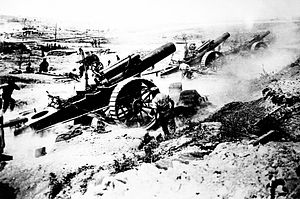How do we know how the next war will be fought, and why does it matter? As the centenary of World War I approaches, several commentators have argued that the emerging multipolar power structure of East Asia is coming to resemble that of Europe prior to 1914. Setting aside the wisdom of the political comparison for a moment, there is one way in which the comparison is apt. Just as real knowledge of modern, high intensity warfare was limited in 1914, the emerging great powers of Asia have little experience with the forms of warfare they are planning to use.
Although most of the European powers had experience with colonial wars, they did not have the space or time to work out the implications of the technologies that would eventually characterize World War I (the machine gun, the dreadnought, the submarine, and the airplane). The degree to which military commanders of 1914 were surprised by these technologies has been wildly overstated, but the armies and navies had not developed the tactic, hands-get-dirty experience of how to fight in a new technological environment.
It bears repeating that we have very little sense of what contemporary air and naval warfare between peer or near peer competitors will look like. This is true not only of land warfare (the U.S. invasion of Iraq in 2003 is probably the best model we have, but isn’t very helpful) but also of naval and air warfare. And in particular, the emerging East Asian powers lack recent combat experience. China last fought a land war in 1980, a naval conflict in 1974. The Japanese military has not engaged in combat since 1945. The Indian military is in better shape because of its anti-guerrilla efforts and constant sparing with Pakistan, but still has little recent experience with major combat.
Of course, good military organizations do their best to simulate what war will look like, and train around those simulations. Exercises such as Red Flag are useful insofar as they contribute to the development of experiential and experimental knowledge. Prior to the air campaigns of the Vietnam War, for example, the United States had little sense of how to undertake air combat, or how to operationally manage a major, modern air offensive. Red Flag emerged from the experience of the war, and over the years has attempted to project the future of war. But as time goes on, the gap between the projection and the actual is likely to grow.
While it focuses on World War II, Christopher Rein’s “The North African Air Campaign” gives a good account of the problem. As Rein argues, the USAAF had good equipment for carrying out a tactical air campaign, and (contrary to some other accounts) also had relatively modern, suitable doctrine. However, the USAAF did not have a great deal of experience fighting a combined arms tactical air war, which left it (for a time) at the mercy of the more experienced Luftwaffe. Even with good planes, good theory, and the assistance of the RAF, working out the kinks in the system took months.
The problem is that there’s no real solution to the problem beyond fighting more wars, a project which is, in and of itself, deeply problematic. Still, estimates of military power in East Asia, and of the relative balance between the contenders, must contend with the fact that we don’t quite know what the next war may look like.

































